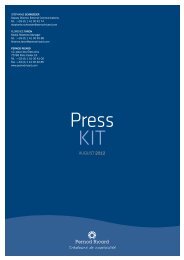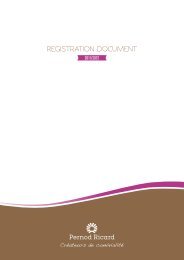Registration Document - Pernod Ricard
Registration Document - Pernod Ricard
Registration Document - Pernod Ricard
You also want an ePaper? Increase the reach of your titles
YUMPU automatically turns print PDFs into web optimized ePapers that Google loves.
4 Notes<br />
82<br />
ANNUAL CONSOLIDATED FINANCIAL STATEMENTS<br />
to the annual consolidated fi nancial statements<br />
The data and assumptions used for the impairment test applied to goodwill and intangible assets with indefinite useful lives of Cash Generating<br />
Units (CGUs) are as follows:<br />
PERNOD RICARD<br />
Method used<br />
to determine<br />
the recoverable<br />
amount<br />
Carrying amount<br />
of goodwill<br />
at 30.06.2009<br />
Carrying amount<br />
of brands and other<br />
intangible assets<br />
at 30.06.2009<br />
Value in use<br />
Perpetual<br />
growth rate<br />
France<br />
237 584<br />
Discount rate<br />
7.33% From (1)% to +2.5%<br />
Europe<br />
Americas<br />
Value in use based<br />
on the discounted<br />
cash flow method<br />
1,603<br />
2,262<br />
3,111<br />
5,803<br />
8.35%<br />
8.39%<br />
From (1)% to +2.5%<br />
From (1)% to +2.5%<br />
Asia/Rest of the World 787 1,813 8.57% From (1)% to +2.5%<br />
A 0.5 percentage point increase in the discount rate would generate<br />
no additional impairment to the value of indefinite intangible assets<br />
and goodwill.<br />
Provisions for pensions and other post-employment benefits –<br />
As indicated in Note 1.18, the Group participates in defined benefit<br />
and defined contribution pension plans. In addition, provisions are<br />
also recognised in virtue of certain other post-employment benefits<br />
such as life assurance and medical care (mainly in the United States<br />
and the United Kingdom). The carrying amount of these provisions at<br />
the balance sheet date is set out in Note 16.<br />
These benefit obligations are based on a number of assumptions such<br />
as discount rates, expected returns on plan assets, average future<br />
salary increases, rate of employee turnover and life expectancy.<br />
These assumptions are generally updated annually. Assumptions<br />
used in the preparation of the financial statements for the year<br />
ended 30 June 2009 and their methods of determination are set out<br />
in Note 16. The Group considers that the actuarial assumptions used<br />
are appropriate and justified, however, changes that could be made to<br />
such actuarial assumptions in the future may have a material impact<br />
on the amount of the Group’s benefit obligations and on its results.<br />
A 25 basis point reduction in the discount rate at 30 June 2009<br />
would have an impact of around €132 million on the amount of the<br />
benefit obligation under the Group’s main benefit plans, which are<br />
in the UK and North America. A change of one point in the rate of<br />
increase of medical and healthcare expenses would have an impact of<br />
approximately €9 million on the amount of the benefit obligation in<br />
respect of post-employment medical and healthcare coverage.<br />
Deferred tax – As indicated in Note 1.21, the deferred tax assets<br />
recognised result mainly from tax loss carryforwards and from<br />
timing differences between the tax and book values of assets and<br />
liabilities. Deferred tax assets in respect of tax losses are recognised<br />
if it is probable that the Group will have future taxable profits against<br />
which such losses will be used. Assessment of the Group’s ability to<br />
use these tax loss carryforwards involves a significant degree of<br />
judgment. Analyses are carried out to conclude whether or not these<br />
tax loss carryforwards are likely to be usable in the future. At 30 June<br />
2009, the amount of deferred tax assets is €1,186 million and is set<br />
out in detail in Note 8.<br />
Provisions – As indicated in Note 16, the Group is involved in some<br />
litigation and claims arising in the ordinary course of its business. In<br />
some cases, the amounts requested by the claimants are significant<br />
and the legal proceedings can take several years. In this context,<br />
provisions are calculated on the basis of the Group’s best estimate of<br />
the amount that will be payable based on the information available<br />
(notably that provided by the Group’s legal advisors). Any change<br />
to assumptions can have a significant effect on the amount of the<br />
provision recognised. The carrying amount of these provisions at the<br />
balance sheet date is set out in Note 16.<br />
Judg ments – In the absence of standards or interpretations applicable<br />
to a specific transaction, Group Management uses its judgment to<br />
define and apply those accounting policies that will provide relevant<br />
and reliable information in the context of the preparation of the<br />
financial statements.<br />
6. Business combinations<br />
Business combinations completed as from 1 July 2004 are recognised<br />
according to the purchase accounting method, in application of IFRS 3<br />
(Business combinations). Identifiable assets, liabilities and contingent<br />
liabilities of the acquired entity are recognised at fair value at the date<br />
of acquisition, after an allocation period of a maximum duration of<br />
twelve months from the date of acquisition. Cost of acquisition is<br />
measured at the fair value of assets given, equity instruments issued<br />
and liabilities incurred or assumed at the date of acquisition, plus any<br />
costs directly attributable to the acquisition. The excess of the cost of<br />
acquisition over the Group’s share in the fair value of the identifiable<br />
assets, liabilities and contingent liabilities is recognised as goodwill<br />
and is subject to impairment tests, at least once a year and as soon<br />
as there is an indication that it may be impaired. Goodwill relating<br />
to the acquisition of foreign entities is denominated in the functional<br />
currency of the acquired activity .<br />
7. Goodwill and intangible assets<br />
Goodwill – Goodwill is subject to an impairment test at least once<br />
a year and as soon as there is an indication that its value may have<br />
been impaired. To perform these tests, goodwill is allocated by<br />
geographical area on the basis of asset groupings at the date of each<br />
business combination. These asset groupings correspond to groups of<br />
assets which jointly generate identifiable cash flows that are largely<br />
independent. The methods and assumptions used for impairment<br />
tests in respect of these asset groupings are set out in Note 1.9. If<br />
impairment is identified, an impairment loss is recognised in profit<br />
and loss for the financial year.<br />
Intangible assets – Intangible assets are measured at cost on initial<br />
recognition. With the exception of assets with indefinite useful<br />
lives, they are amortised on a straight-line basis over their period<br />
of use, which is generally less than five years, and are written down<br />
when their recoverable amount is less than their carrying amount.<br />
Amortisation of intangible assets is recognised within operating<br />
profit in the income statement.<br />
I REFERENCE DOCUMENT 2008/2009 I
















